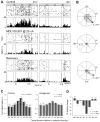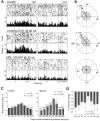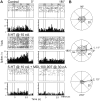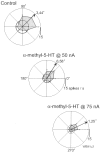The physiological role of 5-HT2A receptors in working memory
- PMID: 11923449
- PMCID: PMC6758292
- DOI: 10.1523/JNEUROSCI.22-07-02843.2002
The physiological role of 5-HT2A receptors in working memory
Abstract
Dorsolateral prefrontal cortex has an essential role in the cognitive process of working memory, dysfunction of which is considered to be a core deficit in schizophrenia. Although this cortical region is densely innervated with 5-HT2A receptors to which atypical antipsychotic drugs bind with high affinity, little is known of the influence of this serotonin receptor subtype on prefrontal function. We addressed this issue by examining the effects of iontophoresis of selective receptor ligands on prefrontal neurons possessing spatially tuned delay activity, or "memory fields," in monkeys performing a delayed-response task. Memory fields of putative pyramidal cells were attenuated by iontophoresis of 5-HT2A antagonists, which primarily produced a reduction in delay activity for preferred target locations. Conversely, 5-HT2A stimulation by alpha-methyl-5-HT or 5-HT itself, accentuated the spatial tuning of these neurons by producing a modest increase in activity for preferred target locations and/or a reduction in activity for nonpreferred locations. The agonist effects could be reversed by the selective antagonist MDL100,907, and were dose-dependent, such that high levels attenuated spatial tuning by profoundly reducing delay activity. A role for feedforward inhibitory circuitry in these effects was supported by the finding that 5-HT2A blockade also attenuated the memory fields of putative interneurons. We conclude that prefrontal 5-HT2A receptors have a hitherto unrecognized role in the cognitive function of working memory, which involves actions at both excitatory and inhibitory elements within local circuitry.
Figures






References
-
- Aghajanian GK, Marek GJ. Serotonin induces excitatory postsynaptic potentials in apical dendrites of neocortical pyramidal cells. Neuropharmacology. 1997;36:589–599. - PubMed
-
- Aghajanian GK, Marek GJ. Serotonin and hallucinogens. Neuropsychopharmacology. 1999;21:16.S–23S. - PubMed
-
- Aghajanian GK, Marek GJ. Serotonin model of schizophrenia: emerging role of glutamate mechanisms. Brain Res Brain Res Rev. 2000;31:302–312. - PubMed
-
- Andreasen NC, O'Leary DS, Flaum M, Nopoulos P, Watkins GL, Boles Ponto LL, Hichwa RD. Hypofrontality in schizophrenia: distributed dysfunctional circuits in neuroleptic-naive patients. Lancet. 1997;349:1730–1734. - PubMed
-
- Arnsten AF, Cai JX, Murphy BL, Goldman-Rakic PS. Dopamine D1 receptor mechanisms in the cognitive performance of young adult and aged monkeys. Psychopharmacology. 1994;116:143–151. - PubMed
Publication types
MeSH terms
Substances
Grants and funding
LinkOut - more resources
Full Text Sources
Other Literature Sources
